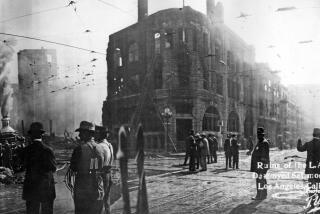Echoes of ’95 Manila Plot
- Share via
The airline bombing plot that British officials said they disrupted Thursday bears striking similarities to a 1995 plot hatched by Sept. 11 mastermind Khalid Shaikh Mohammed and his nephew, Ramzi Ahmed Yousef, in the Philippines.
In that earlier plot, small liquid nitroglycerin bombs were to have been carried aboard as many as a dozen American airliners in East Asia, assembled in flight and timed to explode -- killing all aboard as the aircraft headed east over the Pacific toward the United States.
For the record:
12:00 a.m. Aug. 12, 2006 For The Record
Los Angeles Times Saturday August 12, 2006 Home Edition Main News Part A Page 2 National Desk 0 inches; 28 words Type of Material: Correction
Manila bomb plot: An article in Friday’s Section A said Philippines bomb plotters Ramzi Ahmed Yousef and Khalid Shaikh Mohammed were of Pakistani ancestry. They are Pakistani citizens.
Given passenger loads on the targeted jumbo jets, several thousand people might have died had the plan been carried out. It was disrupted just days before Mohammed and Yousef apparently intended to set it in motion, but not before Yousef had exploded a small test bomb aboard a Philippine Air flight, proving conceptually at least that the plan could work.
The Manila bombs, designed by Yousef, were similar to those thought to have been planned for the British attack in that they were made of relatively innocuous ingredients that could easily pass through airline security screening and be assembled quickly on board.
Yousef, whose given name is Abdul Basit Mahmoud Abdul Karim, and two other men were convicted in the Manila case. Yousef was also convicted in the 1993 World Trade Center attack and is serving a life sentence in the federal Supermax prison in Colorado. Mohammed was charged in the Manila case, but he was not captured until 2003, in Pakistan. He is being held in American custody at an undisclosed location and has never been tried. He has reportedly confirmed many details of the Manila plot.
Yousef and Mohammed, both of Pakistani ancestry, grew up in Kuwait in the 1970s, where their parents had been drawn by the economic boom of the Persian Gulf oil industry. Yousef is the son of Mohammed’s older sister, and they were only a few years apart in school. They each went abroad for college -- Yousef to Britain and Mohammed, along with one of Yousef’s brothers, to North Carolina. They reunited after college in the late 1980s in the camps of the Arab resistance to the Soviet war in Afghanistan.
Yousef had studied electrical engineering, and combined that knowledge with bomb-making expertise he acquired in the camps. He was so successful he later became an instructor in making explosives, which he sometimes referred to as “making chocolate.”
When the Soviets left Afghanistan, Yousef -- with Mohammed’s assistance -- turned his attention to the United States. He led the group that attacked the World Trade Center in 1993, but initially escaped arrest. Soon afterward he and his uncle showed up in Manila, where they dreamed up several plots, including assassinations of Pope John Paul II and President Clinton. After deciding security for the pope and the president would be too difficult to surmount, they focused on the airline plot.
Yousef’s bomb design was sophisticated. He used liquid nitroglycerin that could be stored in contact lens cleaner squeeze bottles; simple cotton batting; and Casio watches that could be programmed and used as timers. All of the bomb ingredients could easily pass security screens. Once on board, a bomber could assemble the explosive in the aircraft restroom, set the timer, then stow it beneath a seat and leave.
Yousef tested one bomb in a movie theater and a second in the Philippine Air plane. The test bombs were small and did relatively little damage -- one man was killed in the airliner, no one in the theater -- but they demonstrated the viability of the bomb design.
Using airline timetables, Mohammed and Yousef devised a scheme whereby five men could, in a single day, board 12 flights -- two each for three of the men, three each for the other two -- assemble and deposit their bombs and exit the planes, leaving timers to ignite the bombs up to several days afterward. By the time the bombs exploded, the men would be far away and far from reasonable suspicion. The math was simple: 12 flights with at least 400 people per flight. Somewhere in the neighborhood of 5,000 deaths. It would be a day of glory for them, calamity for the Americans they supposed would fill the aircraft.
Yousef and another man set about manufacturing the little bombs in an apartment building in Manila. They were nearly ready for the attacks when, in the process of disposing of chemicals on a cooktop in the apartment, Yousef started a fire. Smoke from the fire eventually led Manila police to the scene, where they discovered the bomb-making materials.
Authorities have not said whether the alleged plot in Britain was inspired by the Manila plot, but at least one other attack was. After Yousef was captured, Mohammed reworked the Manila plan. He turned to Osama bin Laden’s Al Qaeda for financing, substituted hijackers for the bombs and used the airliners themselves as missiles to hit targets in America.
More to Read
Sign up for Essential California
The most important California stories and recommendations in your inbox every morning.
You may occasionally receive promotional content from the Los Angeles Times.













